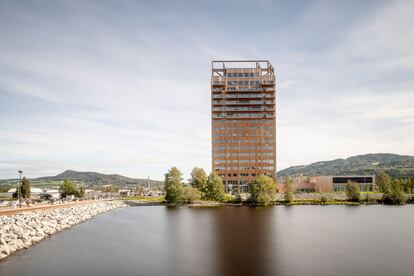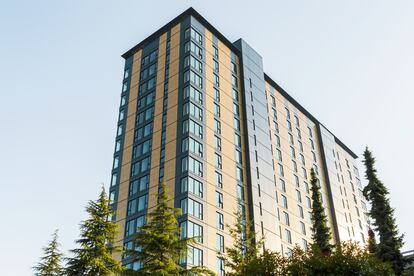The inexorable rise of wooden buildings
Timber is gaining traction as a replacement for classic concrete. It offers a number of design and construction advantages, including being a more environmentally friendly material

“Building skyscrapers more than a thousand meters high may seem obscene or extravagant,” said Austrian architect Harry Seidler in 1963, “but have no doubt that it is perfectly feasible and that sooner or later someone will do it. The destiny of mankind consists of imposing grandiose projects on itself and carrying them out.”
If it hadn’t been for the collapse of Saudi Arabia’s real estate market, Seidler’s old prophecy would have come true over a year ago. The Kingdom Tower in Jeddah, the construction of which came to a halt in spring 2018, had been slated for completion in 2021 and would’ve measured over a kilometer (over 3,280 feet) in height. That would have been the planet’s tallest human-made structure.

The Towers of China, Dubai, Kazakhstan and Malaysia
The Jeddah tower might have been an eccentric and almost obscene act of human hubris. But it wouldn’t have been much taller than the world’s current architectural peak, Dubai’s 829-meter-tall (2,720 feet) Burj Khalifa tower, which opened in 2010. As British architect Peter Cook says, “projects like this are born of that old urge to explore our limits as a species and soar into the sky, something that is already in myths such as the Tower of Babel.” They also emerge from competition between the elite architects who serve emerging economies and feudal satrapies.
While the United States once claimed the tallest buildings in the world, China, Malaysia, the United Arab Emirates and Kazakhstan are now fiercely battling over the world’s highest structure with contenders around 1,000 meters (3,280 feet) in height. By comparison, the tallest building in Western Europe, London’s Shard of Glass, is a diminutive 309 meters (1,014 feet).
However, Old Europe is competitive in another arena that is starting to gain traction of late: wooden skyscrapers. Here the figures are more modest; we are talking about buildings that are dozens of meters tall, not hundreds. Nevertheless, there’s been striking progress in recent years.
From Vancouver’s wooden student tower to Norway’s CLT skyscraper
In 2017, a Canadian student residence hall constructed of cross-laminated timber (CLT), the Brock Commons Tallwood House in Vancouver, made news. The structure measured 53 meters (174 feet), just a few centimeters higher than Bergen’s Treet apartment tower. At that point, the only other tall wooden buildings were religious structures from another era, relics of a period before modern concrete came into vogue, such as Orthodox cathedrals like Almaty’s, and China’s ancient pagoda, the Fogong temple, which was built in the 11th century and stands over 50 meters (164 feet) tall.
Among contemporary high-rises made from wood, the Tallwood House’s strongest competition was Amsterdam’s HAUT building, a 21-floor, 75-meter-high (about 246 feet) structure. However, that project is still under construction; by the time it opens, it will have been overtaken by larger rivals. The first to surpass it was Vienna’s HoHo building, a hybrid wood-concrete 84-meter-high (about 276 feet tall) skyscraper. Completed in 2019, HoHo raised the bar for wooden structures by 31 meters (about 102 feet) in just two years. Very soon after came Mjøstårnet, the Mjøsa Lake Tower in the small Norwegian municipality of Brumunddal, which has 18 floors and is 85.5 meters (about 281 feet) tall. Not only is it a meter and a half (4.9 feet) taller than the Viennese tower, but it does not use concrete reinforcement, making it the world’s tallest wooden skyscraper.

Zurich’s and Milwaukee’s Moment
However, all signs indicate that the Norwegian skyscraper will not be the world’s highest wood building for long. In March 2020, it was confirmed that Milwaukee’s Ascent MKE – a hybrid wood apartment complex – will add five floors to the original project; when that happens in September 2022, the structure will be 87 meters (285 feet) tall.
At the same time, an even more imposing wooden edifice is beginning to take shape in Europe. The Rocket & Tigerli complex in Winterthur, Switzerland – near Zurich – will include four buildings, one of which will be 100 meters (328 feet) tall. The structure’s height is now the project’s main attraction. Additionally, “the design will offer modern, high-quality housing with a maximum inflow of daylight,” Schmidt Hammer Lassen Architects (SHL), the firm behind the building, says.
SHL notes that the project is important “not solely because of its 100 meters, which sets the record for residential buildings with a load-bearing timber construction, but also because it introduces an innovative construction system.”
Kristian Ahlmark, a partner and design director at the Danish firm, adds that “we have always been proactive in our use of the material (wood), not just because of its aesthetic qualities, but also because of the technical construction possibilities it paves the way for. The new production method, presented in this project, brings our love for the material into a modern building.” It’s also much friendlier for the environment.

According to Oscar Holland, a journalist who specializes in trends and design, wooden skyscrapers “were once the preserve of conceptual designers. But thanks to changes in building regulations and shifting attitudes towards the material, they are quickly becoming a reality.” Holland points out that “the construction and operation of buildings accounts for 40% of the world’s energy consumption, and approximately one-third of greenhouse gas emissions. But while concrete emits a huge amount of carbon, trees instead absorb it throughout their lifetime.” The journalist also notes that “the developers of Milwaukee’s Ascent apartment complex… claim that its use of timber represents the equivalent of taking 2,100 cars off the road.”
Irene Jimeno, an architect and conservationist who maintains the informative blog Toca Madera (Touch Wood), believes that the figure that Milwaukee’s developers provided is plausible: “Above all, building with wood is excellent business for the planet.” As she sees it, the material has a number of design and construction advantages, beginning with speed and precision. “But the main thing is that it fits perfectly into circular economic models that make it possible to reduce energy waste and carbon footprints.” Its impact on the forest “is very positive if done through responsible and sustainable forest management.” That means replenishing the trees that are cut down with continuous reforestation.
Jimeno asserts that “wood is a building material that has a tradition and cultural roots; it’s also very legitimate.” Almost anything can be made with wood. Monumental architecture and high-rise construction are no exceptions. She notes, however, “I am not really in favor of creating competitive dynamics and arbitrarily adding floors to residential projects to break records.”
She believes that doing so trivializes architecture by giving it a speculative dynamic, which ultimately makes it less responsible and sustainable. Jimeno appreciates the Rocket & Tigerli and Mjøstårnet buildings primarily because “they are technical achievements and very eloquent examples of the virtues of the material they use…whether they have a couple of floors more and are a few meters higher strikes me as irrelevant and a bit toxic.”

The next evolutionary leap
In coming years, experts believe that the wood revolution will be unstoppable because of a decisive factor: cost. Holland notes that “as mass timber becomes increasingly common, more CLT factories are built and economies of scale reduce prices.” To a certain extent, Holland says, the ambitiousness and scale of the HoHo and Rocket & Tigerli projects – and others like them – stem from these changing market trends.
Two record-breaking building projects are still awaiting final approval. One is London’s Oakwood Tower, an 80-story skyscraper. The building would form part of the Barbican residential complex and measure 300 meters (984 feet) in height.
The other skyscraper, which was proposed in 2018 in Tokyo, has been provisionally named Project W350, a 350-meter-tall (1,148 feet) wooden structure reinforced with 10% steel to better withstand earthquakes and strong windstorms. Construction on the building is scheduled to begin in 2024, and it is expected to be completed in 2041. By then, if the forecasts are accurate, cities such as Chicago, Philadelphia, Perth and Eindhoven will be home to wooden skyscrapers over 100 meters (328 feet) high.
Tu suscripción se está usando en otro dispositivo
¿Quieres añadir otro usuario a tu suscripción?
Si continúas leyendo en este dispositivo, no se podrá leer en el otro.
FlechaTu suscripción se está usando en otro dispositivo y solo puedes acceder a EL PAÍS desde un dispositivo a la vez.
Si quieres compartir tu cuenta, cambia tu suscripción a la modalidad Premium, así podrás añadir otro usuario. Cada uno accederá con su propia cuenta de email, lo que os permitirá personalizar vuestra experiencia en EL PAÍS.
¿Tienes una suscripción de empresa? Accede aquí para contratar más cuentas.
En el caso de no saber quién está usando tu cuenta, te recomendamos cambiar tu contraseña aquí.
Si decides continuar compartiendo tu cuenta, este mensaje se mostrará en tu dispositivo y en el de la otra persona que está usando tu cuenta de forma indefinida, afectando a tu experiencia de lectura. Puedes consultar aquí los términos y condiciones de la suscripción digital.
More information
Últimas noticias
Luisa Neubauer, climate change activist: ‘Ecology shouldn’t be a punitive force, but a joyful and liberating one’
Trump followed CIA recommendation to hand power to Delcy Rodríguez due to risk that Machado would not control the army
The Motherwell painting that Franco wanted to hide from view
Mexico seeks to shore up its defenses following US incursion in Venezuela
Most viewed
- Alain Aspect, Nobel laureate in physics: ‘Einstein was so smart that he would have had to recognize quantum entanglement’
- Alvin Hellerstein, a 92-year-old judge appointed by Bill Clinton, to preside over Maduro’s trial in New York
- Cuba confirms death of 32 of its citizens in the US attack against Venezuela
- Gilles Lipovetsky: ‘If you want to live better and fall in love, take Prozac, don’t look to philosophy’
- Why oil has been at the center of Venezuela-US conflicts for decades











































